Éric Roy was put in charge of the first team back in January.
This was the 56-year-old’s first manager’s job since he was in the Nice hot seat in 2011—more than a decade prior.
Roy had seemingly left coaching behind him, serving as sporting director at Nice (2011-2012), Lens (2017-2019), and Watford (2019-2020) during his decade-plus absence from the technical area.
After his spell at Watford, which ended just after the Hornets’ 2019/20 Premier League relegation, Roy took a break from football altogether.
He took some time to refocus on his objective of returning to management, which he has done in style.
Initially tasked with ensuring Brest’s Ligue 1 survival last season, he’s now got the Brittany port city thriving in the top flight.
This tactical analysis
will break down three critical aspects of Éric Roy’s tactics at Stade Brest that have led to the club’s high performancethis term.
Our analysis will touch on Brest’s long passing, crossing and pressing; their success with implementing their tactics in these areas is why they currently top the league standings in France.
Éric Roy Tactics – Direct play from the back
To kick off our analysis, we’ll focus on Brest’s in-possession play, precisely their direct nature and tendency to go long from the back.
The side with the seventh-highest average possession (50.7%) this season has also played the most long balls (46.67 per 90) in France’s top flight.
Marco Bizot Pass Map
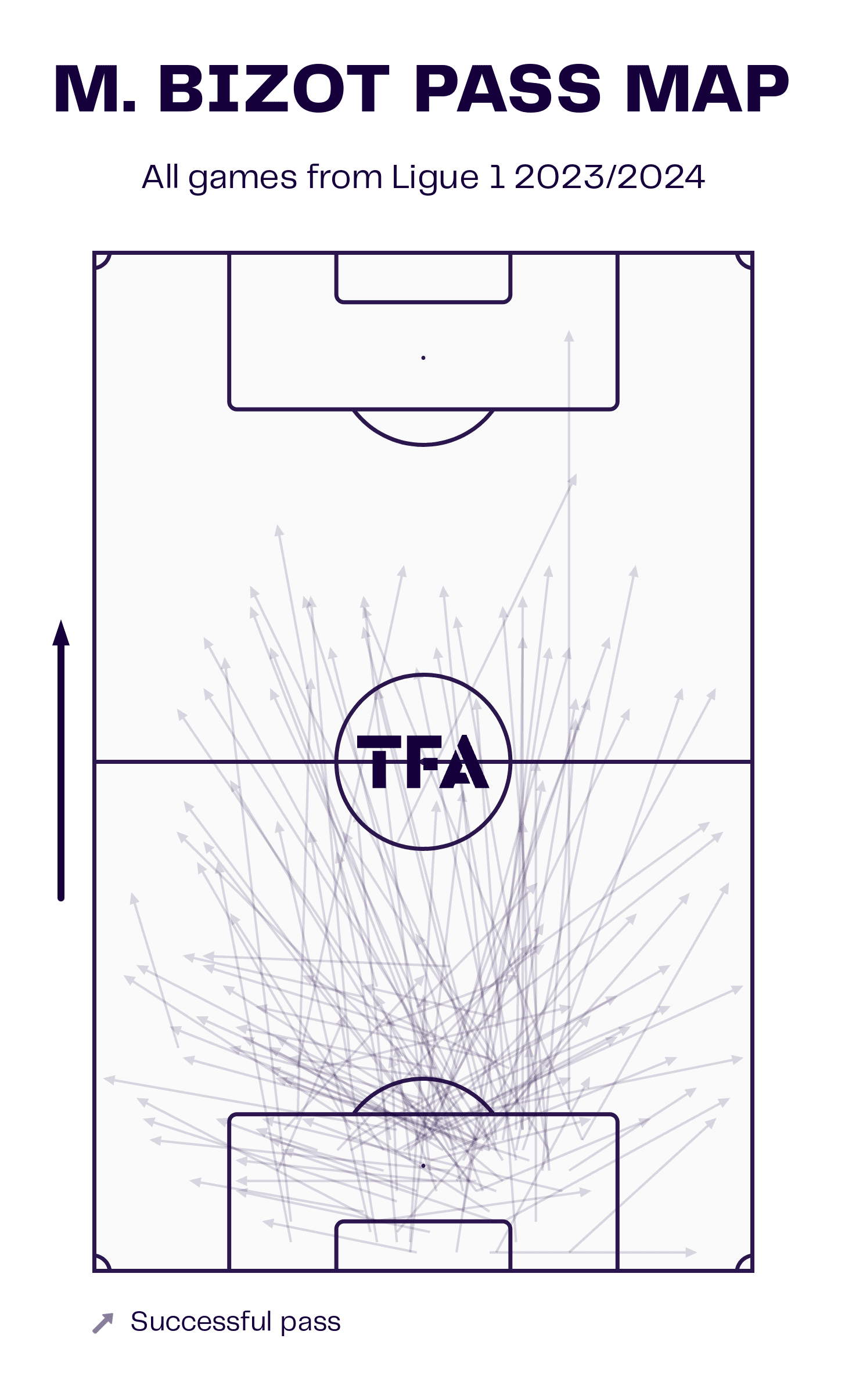
There’s clearly no significant directive from the coach to play it out short from goal kicks; rather, Brest tends to prefer to go direct.
In doing so, they primarily look to exploit their centre-forwards’ aerial ability.
Steve Mounié has been a top asset for Les Pirates since joining the club from Huddersfield Town in 2020.
He offers a significant aerial threat, ranking in the 98.2 percentile for both aerial duels per 90 and aerial duel success percentage among centre-forwards from Europe’s top-five leagues last season.
Within his realm, he’s essentially untouchable; it’s then just about finding ways of making the most of his assets.
Mounié’s aerial threat isn’t limited to within the box.
By targeting the opposition’s goal off the end of a cross, he can also help his team quickly gain ground and put the opposition’s defensive line under immediate pressure.
This is one way Roy has aimed to use Mounié during his time with Brest—an outlet to win aerial duels and control long balls with his chest before sending the ball towards a teammate who can charge at the opposition’s defence.
This season, however, Mounié has not been the undisputed star of Brest’s attack.
He’s played more of a bit-part role, allowing 22-year-old Martín Satriano to take the spotlight up front.
On loan at Stade Francis Le Blé from Serie A giants Inter this term, Satriano has started all but one of Brest’s league games — their only league loss this season being the exception, a 2-0 loss to Marseille.
The Uruguayan attacker is slightly shorter than Mounié, 187cm, to the Beninese player’s 190cm.
He’s not quite as strong in the air—because nobody is as strong in the air as Mounié —but he still represents a competent option for Roy’s settled style of play with Les Pirates, including their direct play from the back towards the centre-forward.
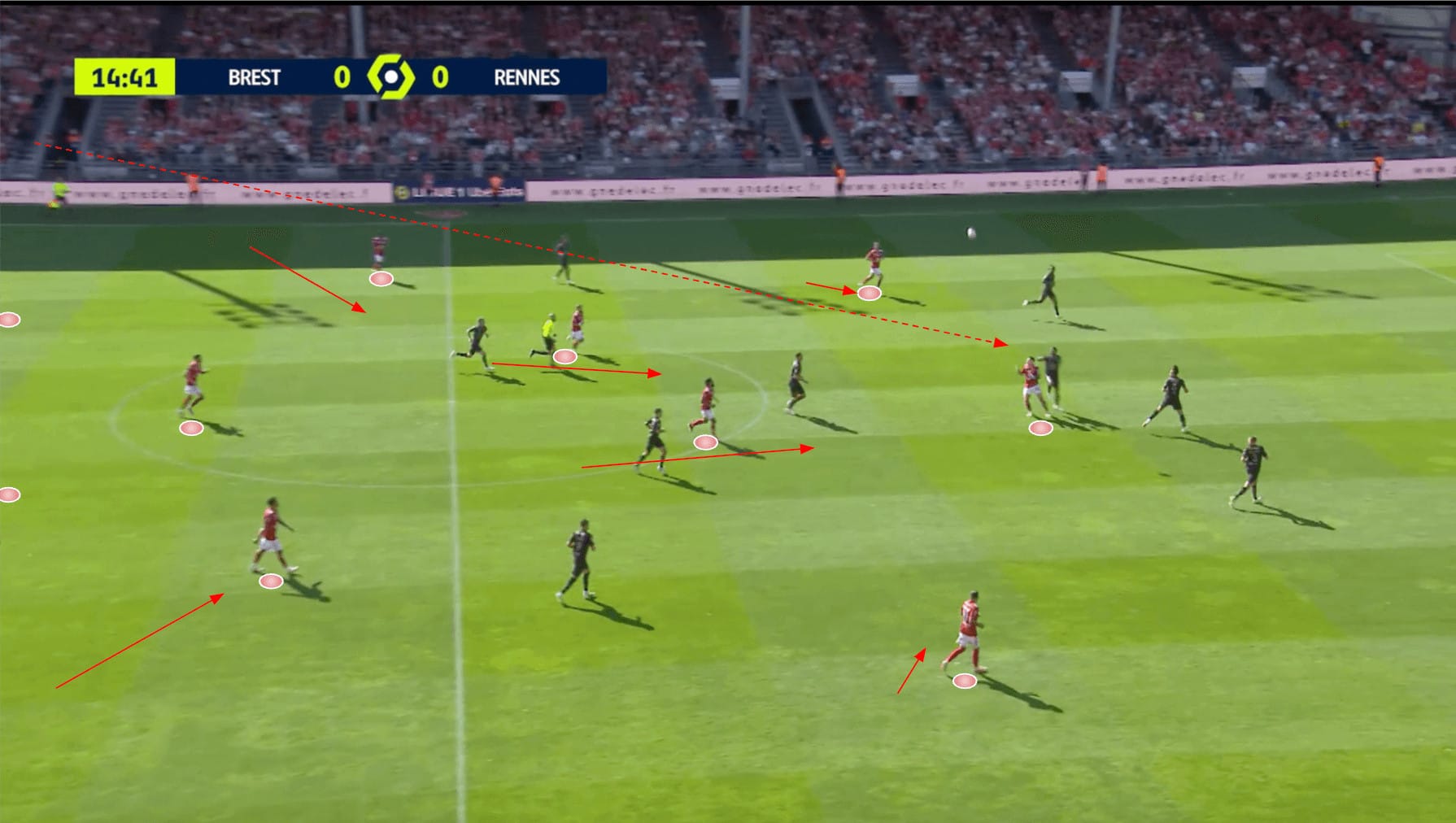
Here, we have an example of the ball being sent long to Satriano from Bizot.
As the ball nears the attacker’s head, the wingers and central midfielders get closer to support the striker and prepare themselves to challenge for the second ball.
Also, note how Brest’s full-backs tuck inside, further bulking up Les Pirates’ presence in the centre.
This increases their chances of winning the second ball by having lots of bodies around this area and lots of close, short passing options once the ball drops to one of their players’ feet.
This is a ubiquitous sight for Brest when they’re progressing out from the goal kick.
With their capable centre-forwards on the receiving end of Bizot’s long balls, along with the pressing energy and organisation from those positioned between the two, Brest did well with this approach in 2023/24, finding ways of regularly placing the opposition’s backline under pressure.
Chance creation
In terms of chance creation, then, Brest can hold their heads high, doing enough to boast the sixth-best xG (10.72) in Ligue 1 this term, generating the fourth-highest shots tally (14.44 per 90).
Stade Brest Shots Map Ligue 1 2023/2024
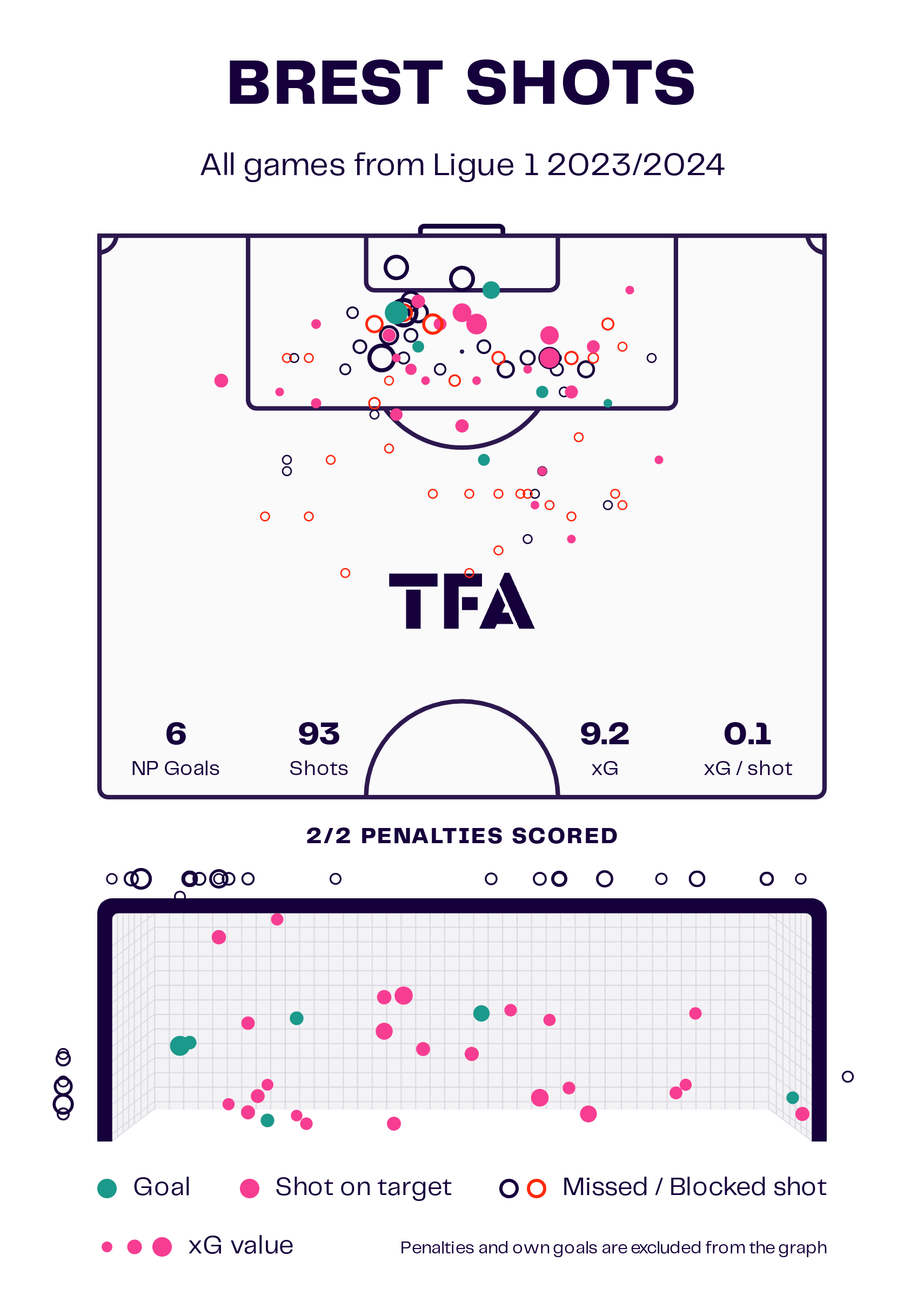
From Figure 3, we can confidently say Brest doesn’t have the best shot locations of all time, with a fairly scattered graph resulting from too many speculative efforts.
This is one less positive reason for their high shots tally — they aren’t overly cautious with firing.
Regardless of that, they still have generated plenty of high-value shots from good positions, plenty of which they have also failed to convert, indicating they need to be more clinical in front of goal.
Stade Brest Shots Assists Map Ligue 1 2023/2024
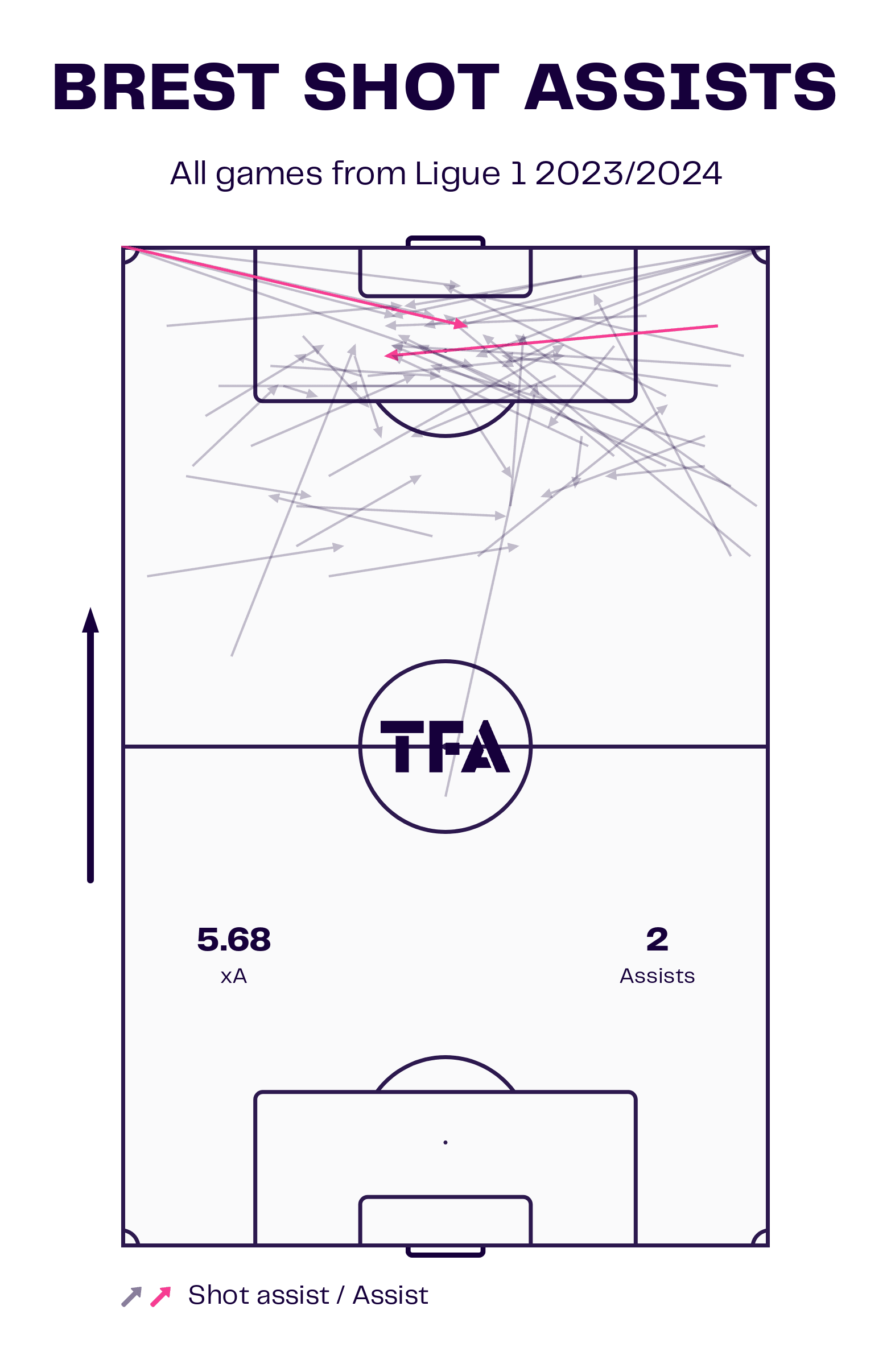
Their failure to take chances hasn’t been due to a lack of their playmakers’ efforts in chance creation, though.
They’ve generated a decent 5.68 xA this term, though that’s resulted in just two assists.
From their shot assist map, we can clearly see that they rely heavily on crossing from a playmaking point of view.
Again, this makes sense when you consider the profiles of centre-forwards at their disposal and the way they’ve developed to suit this under Roy.
Brest really doesn’t penetrate the backline with through balls for a striker to chase in behind much at all—it doesn’t get the most out of Mounié or Satriano.
This is why they’ve generated the fewest offsides in Ligue 1 this term (0.61), as they come more often when looking to exploit a pacey attacker’s movement in behind with a ball over the top or a through ball.
Instead, they work their way into crossing positions out wide and aim to find the striker in a valuable position from which they can finish—either aerially or on the ground.
Four key players are to be mentioned when it comes to Brest’s chance creation—the first two are their wingers, typically Romain Del Castillo and Jérémy Le Douaron, this season.
Roy instructs his wingers to stay wide.
They hug the touchline almost exclusively, constantly providing passing options out wide as Brest looks to break the opponent down and generate a chance for the striker.
Romain Del Castillo And Jérémy Le Douaron Touch Map
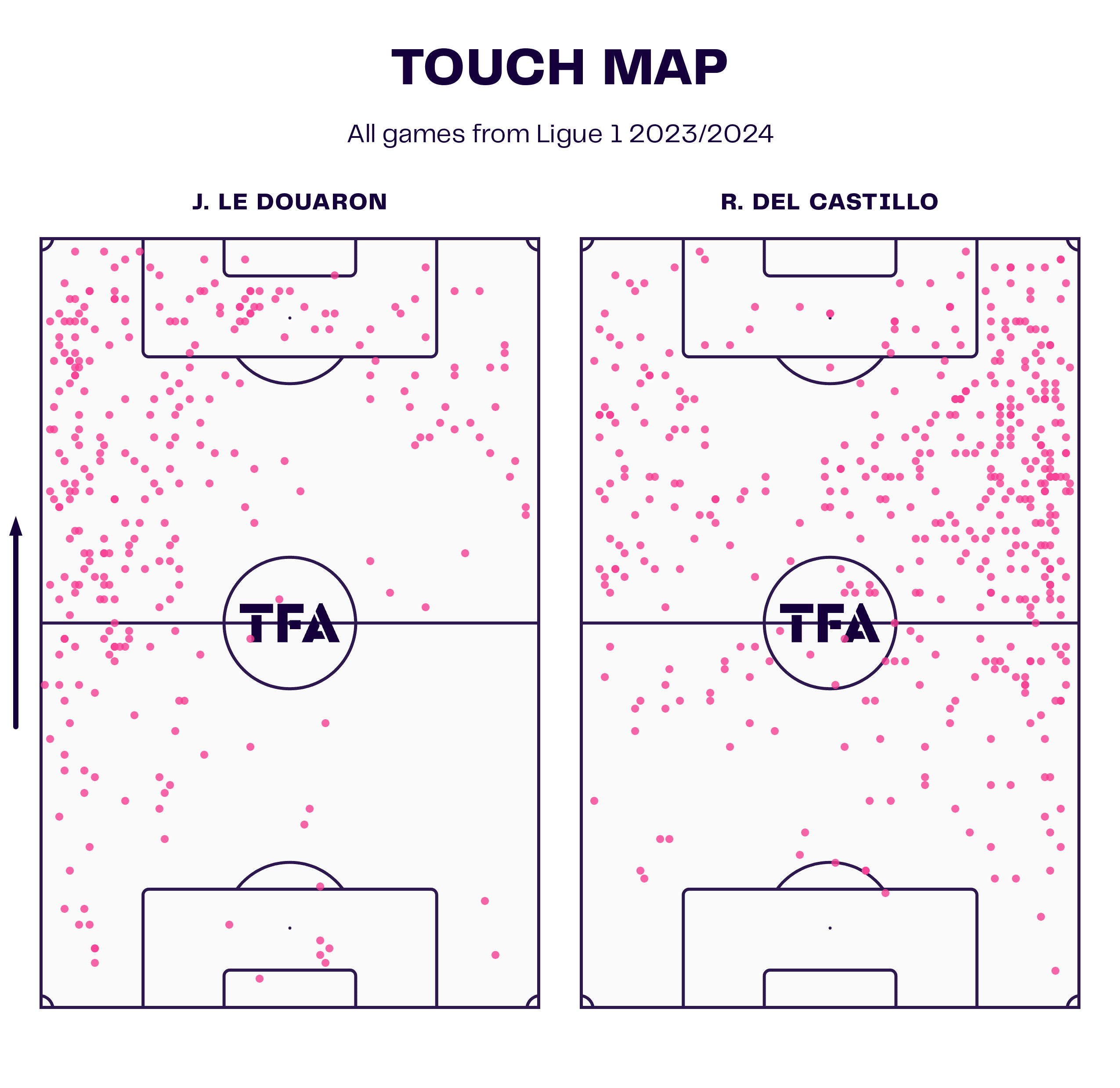
Le Douaron mainly plays on the left as a traditional left-footed left-winger, while Del Castillo plays typically on the right as an inverted left-footed right-winger.
However, Roy has experimented with switching the pair up too.
Del Castillo has been highly effective off the right.
However, generating 2.35 xA on his own this term, so his being inverted certainly appears optimal for the moment.
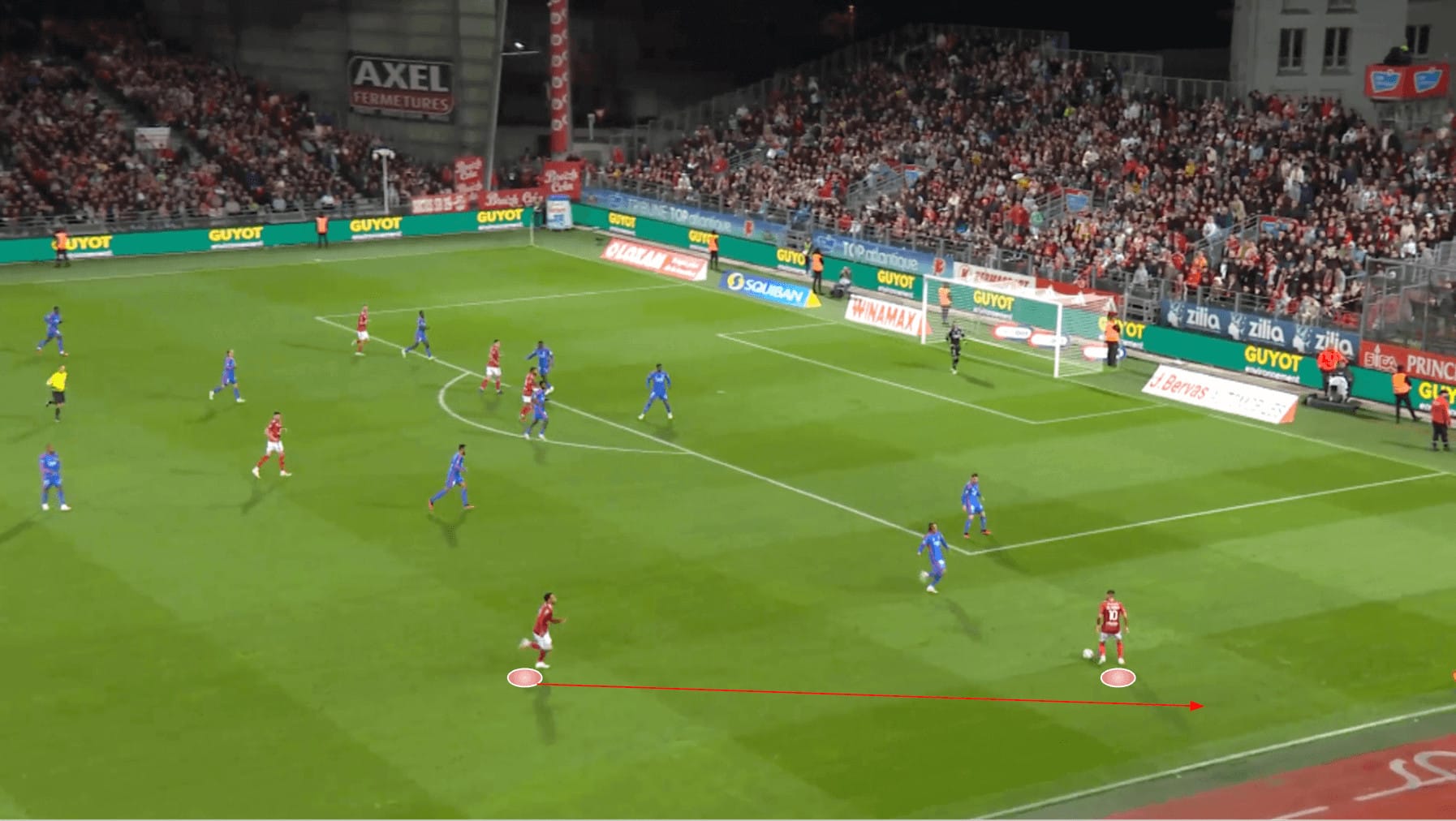
As the opposition will know, or at least should know, of Del Castillo’s intention to cut onto his left foot before crossing from the right, the winger has relied on his teammates’ support to pull off this move.
We have one such example in figures 6-7.
Firstly, note Kenny Lala‘s narrow positioning in Figure 6 — a result of how Brest’s full-backs move in possession primarily to support the aerial duel and for counter-pressing purposes, as mentioned earlier — as the right-back begins a run on the outside of Del Castillo to support the creative 27-year-old as he tries to forge a crossing opportunity.
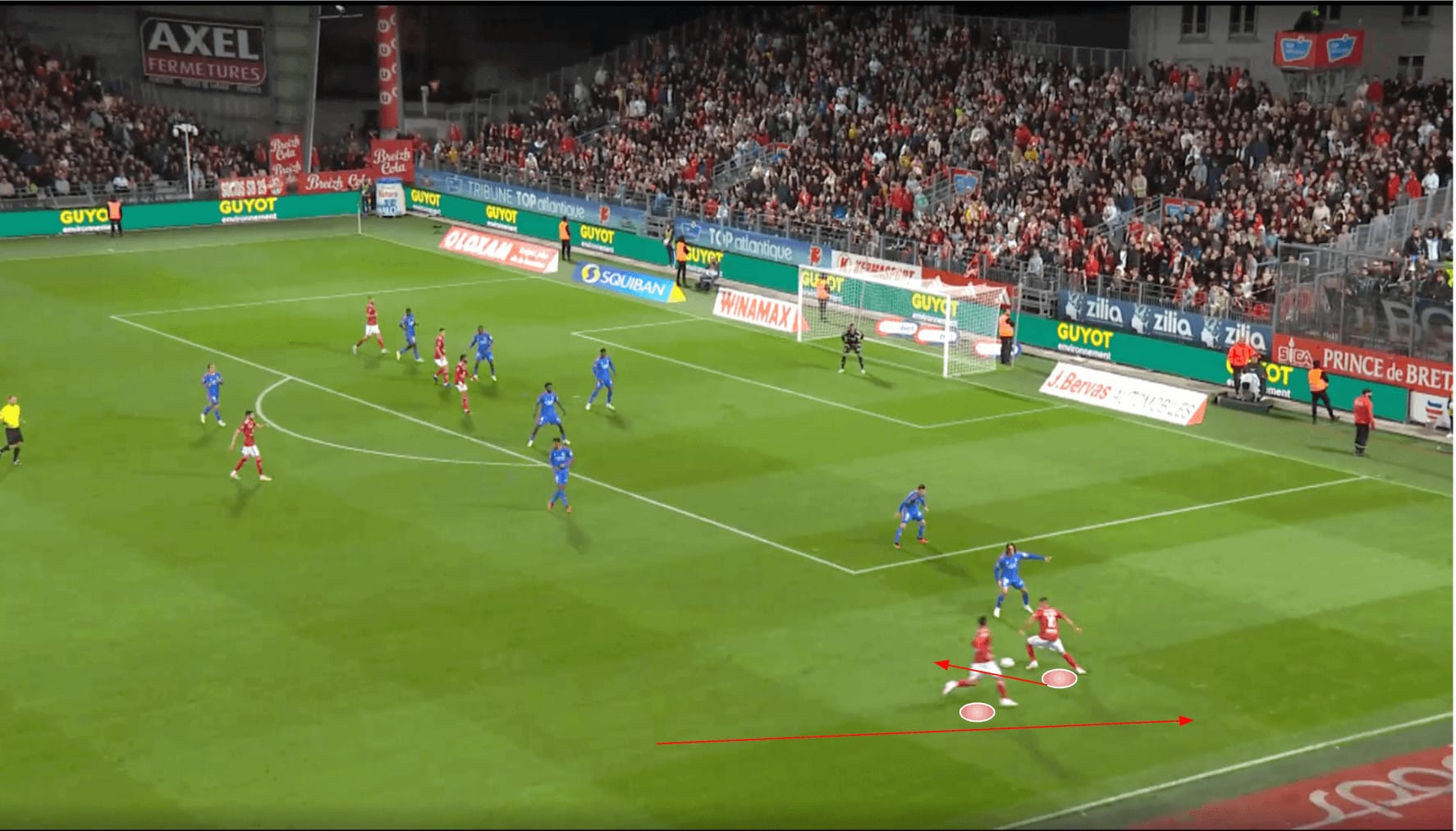
Lyon’s winger, Diego Moreira, gets preoccupied with Lala’s run and allows Del Castillo to cut onto his left foot to create a dangerous inswinging cross opportunity.
This moment of uncertainty is all Del Castillo needed to capitalise and make his move, punishing Lyon with a very inviting lofted cross towards the back post for his Brest teammates to attack.
This is just one example of how Brest’s players contribute beneficial, unselfish off-the-ball movement to help their crossers in chance creation.
Bradley Locko And Kenny Lala Touch Map
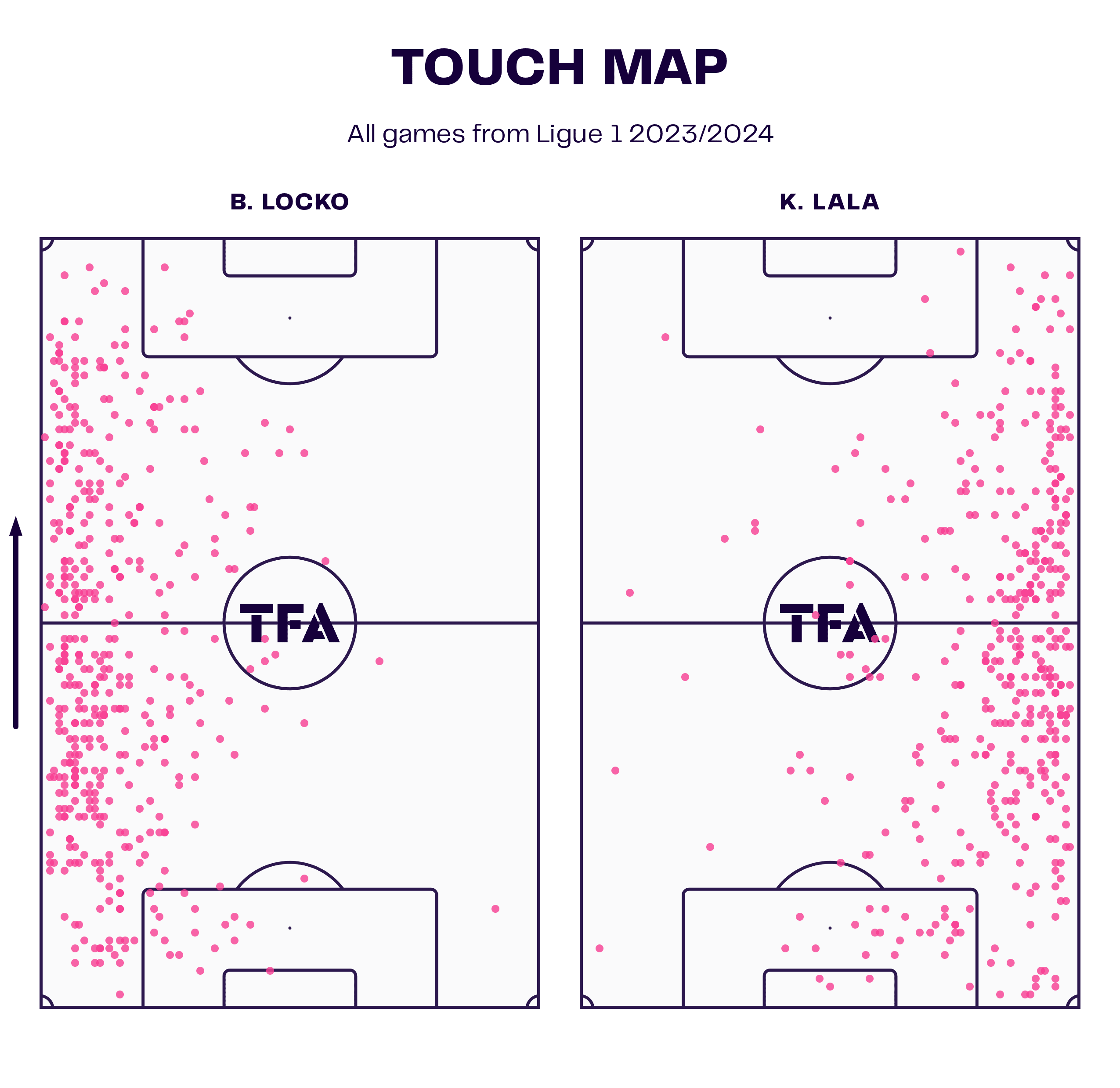
The other two key players for Les Pirates in chance creation are their full-backs, typically Lala on the right and Bradley Locko on the left.
As we look at figure 8, the first thing to note is that Brest’s full-backs don’t tend to get very high.
With the wingers staying wide in the final third, the full-backs are denied space to drive forward unless they provide a supporting run like Lala in figures 6-7.
As a result, we typically see this duo hang back on the edge of the final third.
Again, it’s common for Brest’s full-backs to get relatively narrow, as depicted on their respective 2023/24 touch maps.
This occurs more in the progression phase after the long ball is sent forward, giving Brest’s outfielders a second ball to hunt down and press in central areas.
Lala has generated 1.09 xA this term, while Locko has 0.24 xA.
If we quickly return to Figure 4, we can see some crosses originating from high and some from deeper areas or even more central areas.
The full-backs’ crosses come from the latter two — deep or more centrally towards the half-space.
Their support in these positions and capability to pull off a dangerous ball into the box from there has been crucial to their side’s chance creation this term.
Indeed, both the right-winger and right-back have generated more chances than their left-sided teammates this term.
It’d be fair to say that Brest relies heavily on their right side, directing a lot of play through that particular wing.
This often results in chances being directly created from the right and crosses coming in from that side, but Brest has also adhered to the overload-to-isolate principle at times this term, which has been another successful aspect of their chance creation.
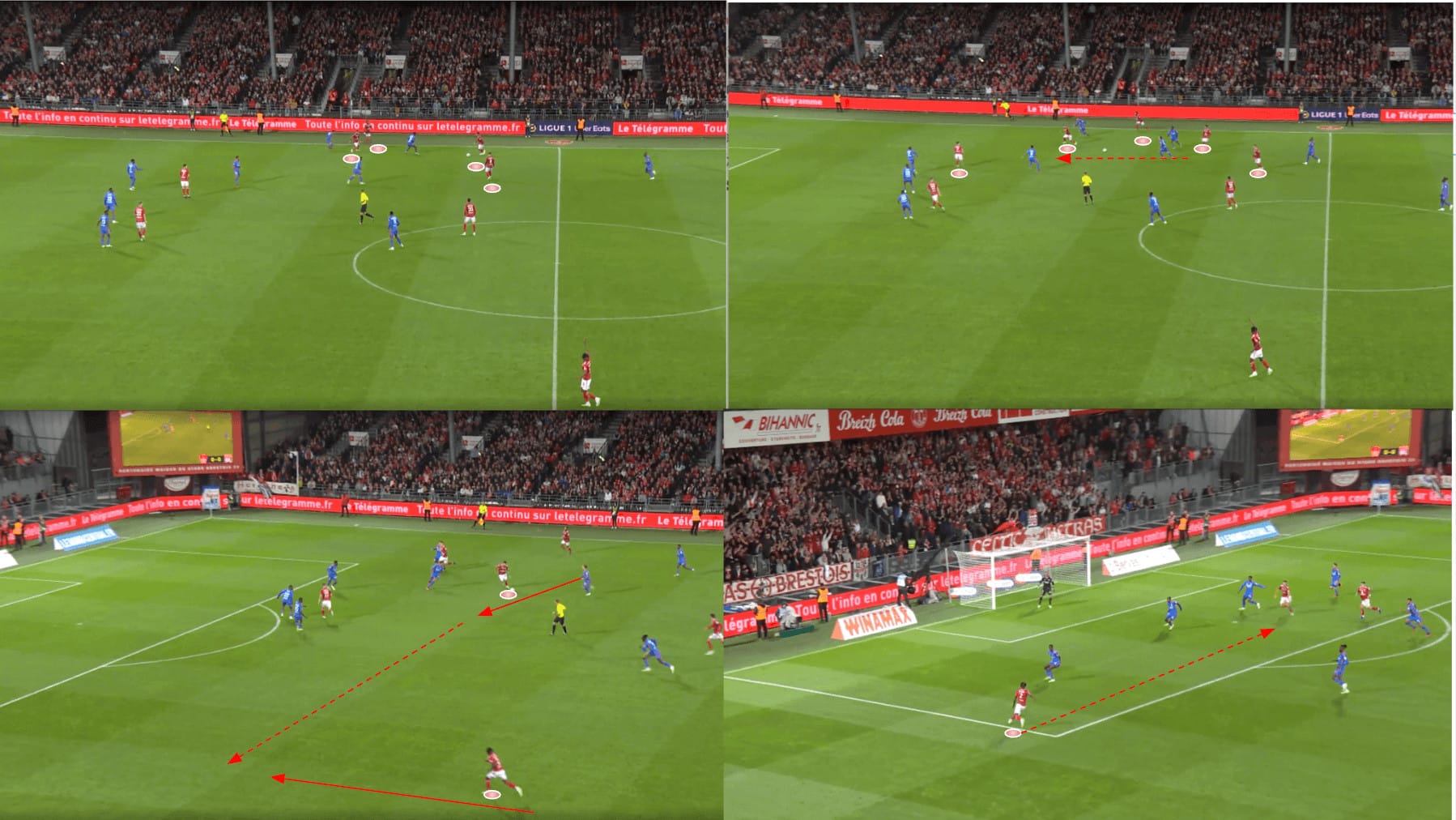
Take Figure 9, for instance.
Here, we see how Brest has committed bodies to the right, ensuring they have the overload there, which helps them to find a way into the final third.
The ball carrier inside the final third moves slightly across into the right half-space, opening up an angle to switch the play to left-back Locko, driving forward from deep to exploit the now-open space on that wing as a result of the left-winger’s movement towards the right to support the initial overload.
Locko is isolated out wide and can drill a low cross into the penalty area for an attacker to get a shot on target.
Brest has been very effective with this principle in 2023/24.
Their opponents must be careful with it, as allowing Locko that much space is dangerous and will result in chances for Satriano and Mounié.
Brest’s press
Our third and final section focuses on Brest’s out-of-possession play, particularly their high block.
They’ve deployed a very effective and aggressive press in 2023/24, which has also acted as a major playmaker for them.
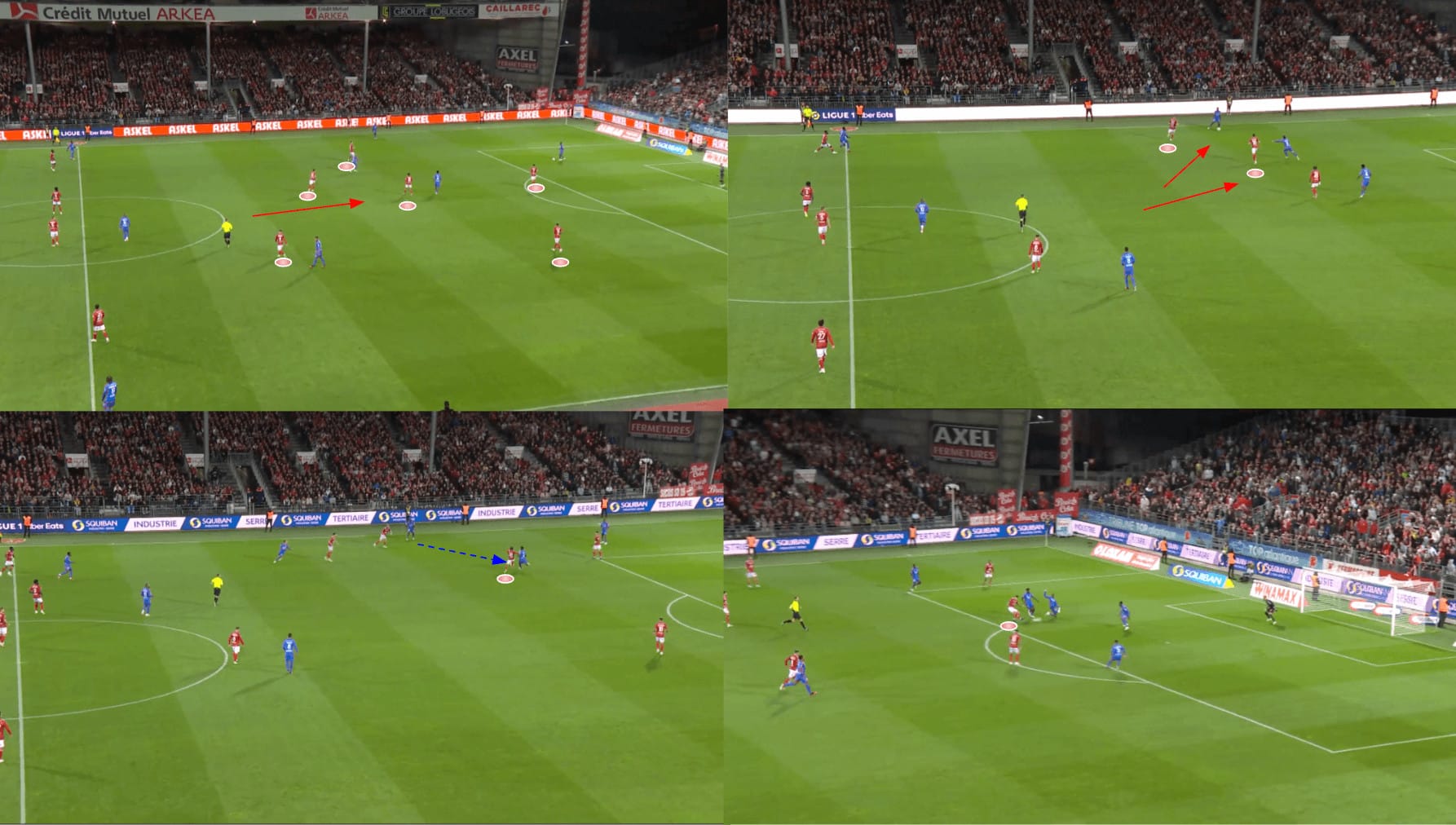
Roy has primarily lined his team up in a 4-2-3-1 base shape this term, but that has quickly turned into a 4-1-4-1 in some games due to the nature of Les Pirates’ press, which instructs the central midfielders to man-mark the opposition’s midfielders quite closely.
In Figure 10, Brest’s left central midfielder advances, freeing up the left winger to press the opposition’s right-back as he receives the ball—reasonable anticipation of the pass from the left central midfielder.
We witness more impressive anticipation from this left centre-mid, Hugo Magnetti, as he makes a high interception when the Lyon right-back tries to pass the ball into the centre to the midfielder whom Magnetti is fiercely guarding.
Following on from here, Brest can quickly get a shot off from just inside the box, demonstrating how efficiently they can transform these turnovers into goalscoring opportunities.
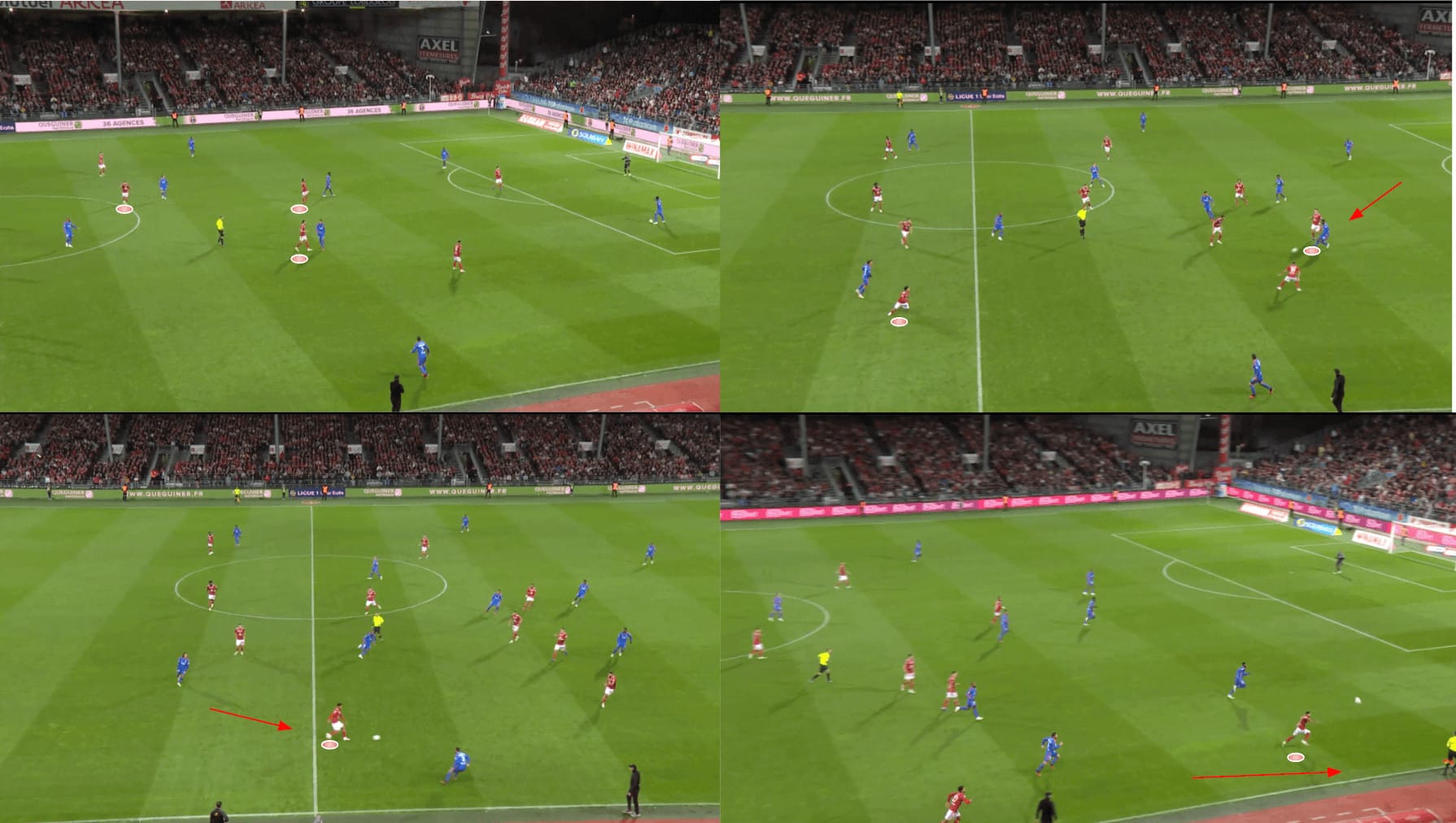
Figure 11 further highlights the role of Brest’s midfielders in sticking extremely tight to their opposite numbers.
In this case, their tight marking put the Lyon centre-back off attempting to pass through midfield.
However, as the centre-back carried the ball out, he was closed down aggressively by the centre-forward, who’d cut the pitch in half initially, blocking the centre-back from playing across his goal.
Now, the centre-forward is charging the ball carrier down in a bid to halt Les Gones’ forward movement and regain possession.
The centre-back was then rushed into a hasty decision, attempting to play the ball out wide for the full-back to run onto.
The pass was subsequently intercepted by the right-back, who showed great anticipation and could then take advantage of the out-of-position Lyon defenders by driving a through ball into the path of the winger just ahead.
From the midfield marking, the centre forward’s diligent pressing, the right back’s excellent anticipation and intelligent passing afterwards to take advantage of the vacant space out wide, along with Del Castillo’s run, this example shows a lot of what makes Brest’s out-of-possession play so difficult to play against right now.
They’re a well-organised side full of players who understand and seemingly buy into the coach’s methods.
And why not when they’re producing results as they are at the moment?
Brest Defensive Territory Map
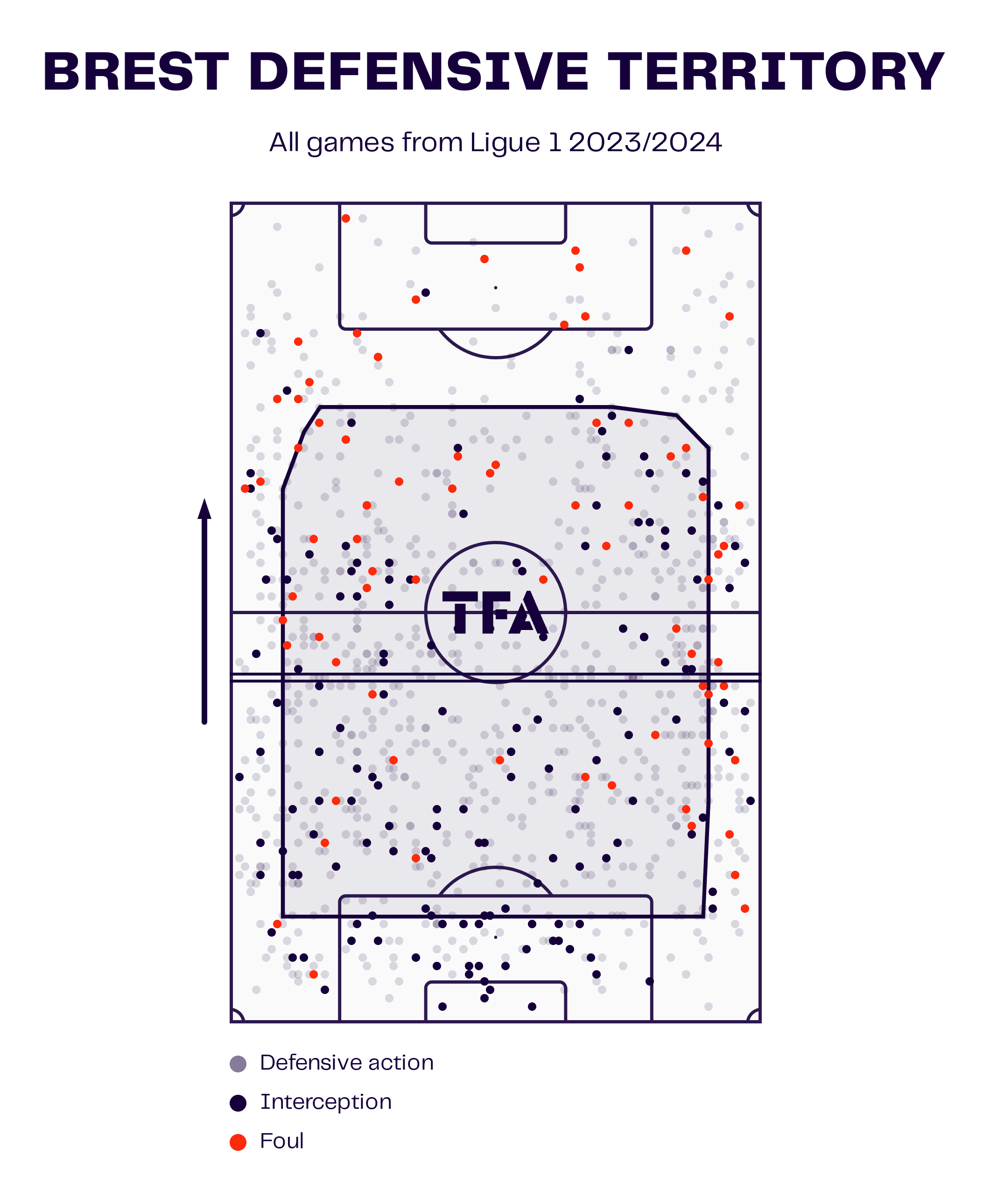
With their PPDA of 8.58 being the third-lowest in France’s top-flight in 2023/24 thus far, Brest have got quite a high average defensive line height for the season to date, as figure 12 shows.
Brest High Regains Map
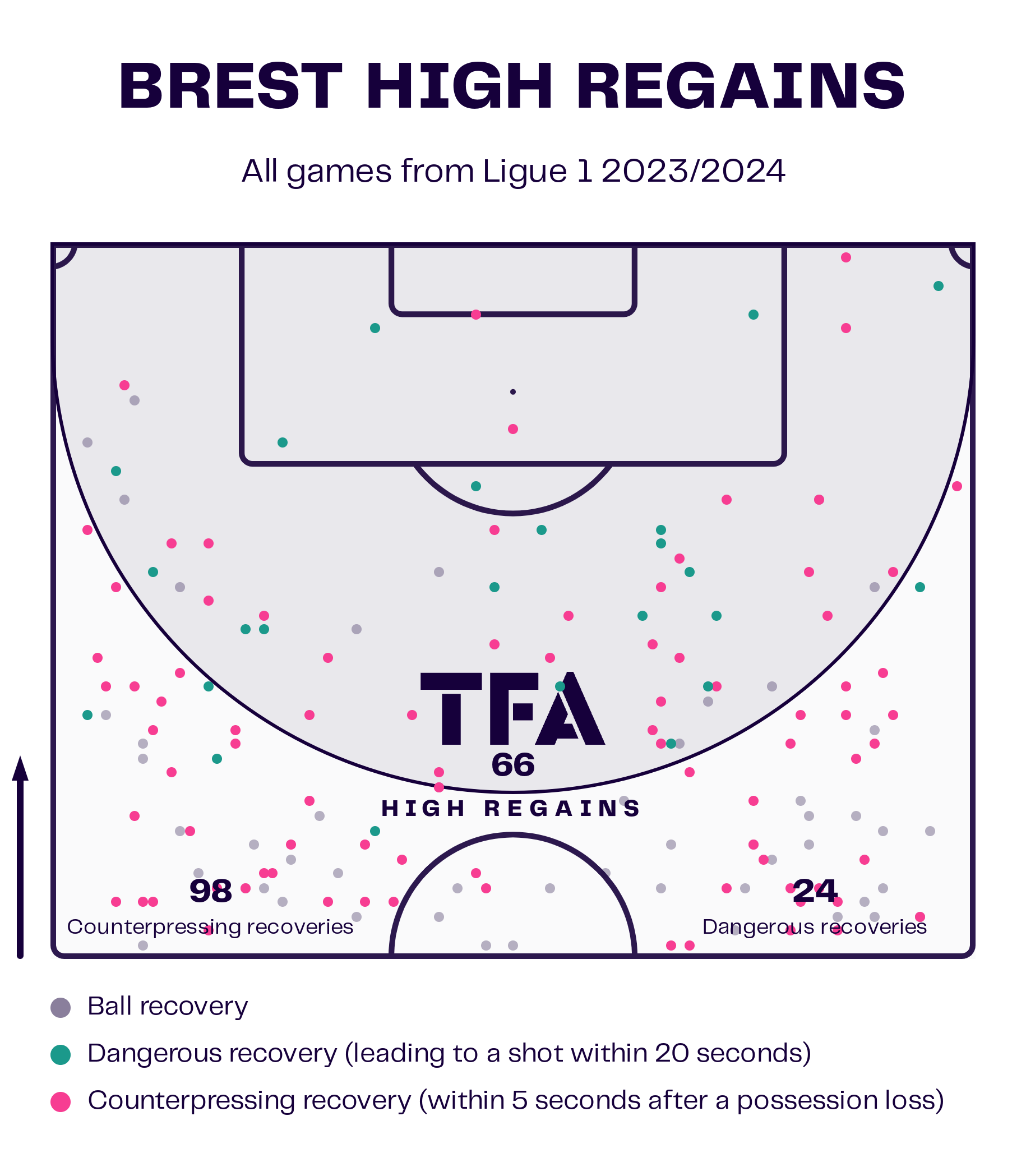
Furthermore, they’ve generated 24 dangerous recoveries along with 66 high regains this season, further highlighting how good they are at using their press as a playmaking tool.
Their counter-pressing in transition to defence has also been a significant part of their game this term, as the 98 counter-pressing recoveries marked on the image above would suggest.
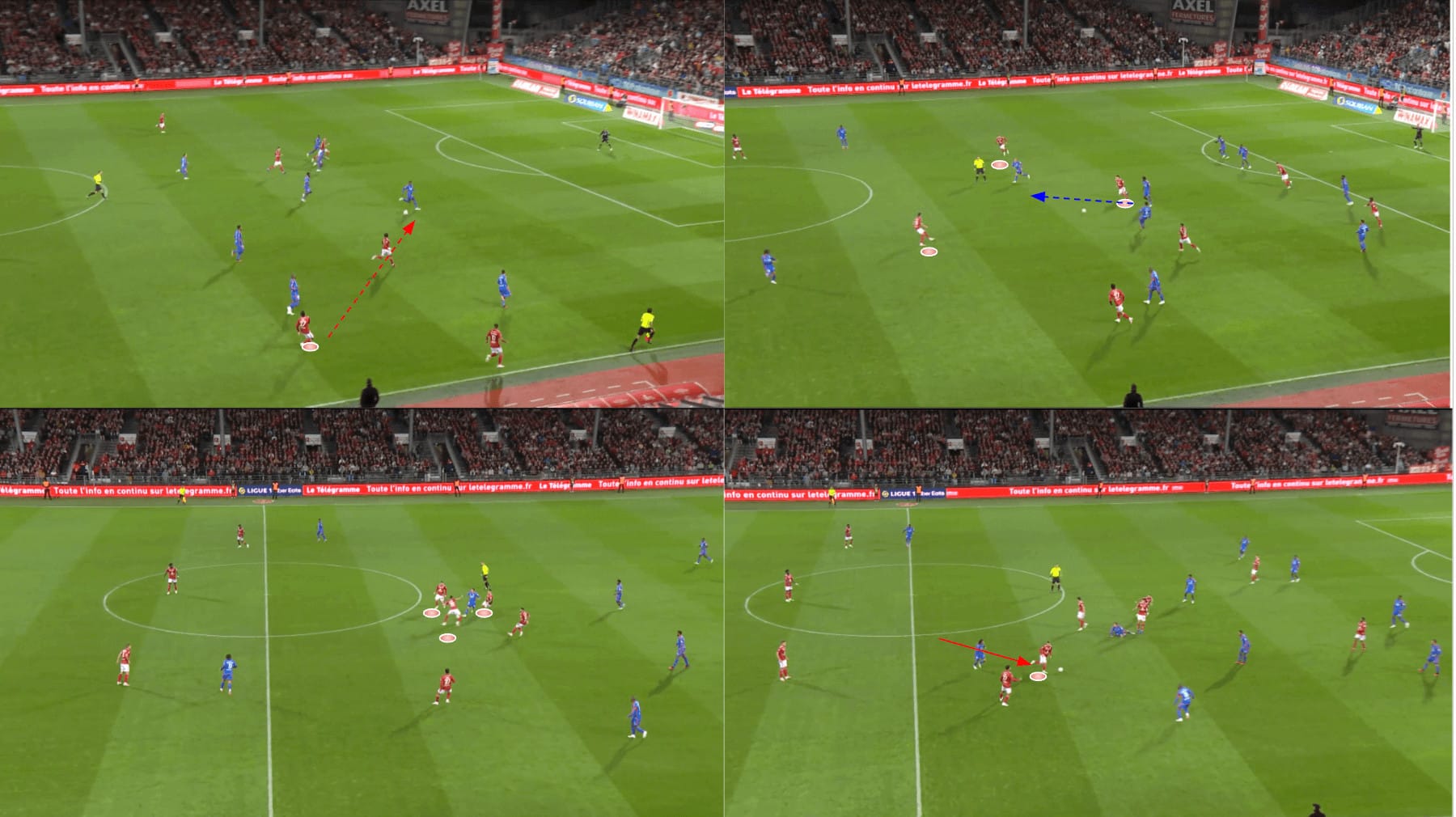
Here in Figure 14, after losing possession while aiming to break into the final third, Brest quickly regroups and crowds around the ball carrier in a pack before Lyon can even manage to exit their own half.
Brest’s organisation and intensity in the counter-press suffocate Lyon’s ball carrier, denying them the opportunity to continue moving forward, regaining possession in the middle of the park, and giving Les Pirates another chance to break into the final third.
Roy’s side’s counter-pressing has been vital to their success this season, and maintaining these levels in transition to defence is paramount if they are to sustain their current quality of performance.
Conclusion
To conclude this tactical analysis, Brest has a clear identity under Roy this season that the coaches have crafted around their players and their individual characteristics, which is to thank for their stunning start to the 2023/24 campaign.
Brest fully earned every point they’ve taken from the opening six games of the league season.
If they maintain their energy levels, fitness and belief in the coach’s methods, there’s no reason they can’t sustain their high-performance levels for longer.
However, we must expect opposition teams to adapt and throw different challenges at Brest as they get familiar with their game, which will require Roy also to be adaptable.





Comments